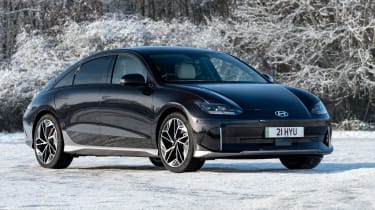What is a heat pump? Costs and range benefits in electric cars explained
You may have heard the term ‘heat pump’ when shopping for an electric car. But what is a heat pump, and do you need one?

Efficiency is the name of the game when it comes to electric cars. Manufacturers have engineered all sorts of solutions with the aim of increasing the range of their electric cars, from regenerative braking systems to ultra-aerodynamic body shapes. The heat pump is another arrow in the quiver that manufacturers can use to reduce the load on an electric car’s battery and, therefore, eek out a few extra miles of range.
What is a heat pump?
In essence, a heat pump is used to increase or decrease the temperature of either the cabin, batteries or both in an electric car. The overwhelming majority of electric cars use lithium-ion batteries which provide the best balance of efficiency, performance and cost-effectiveness. However, much like the battery in your smartphone, they can’t perform at their maximum efficiency in extreme temperatures, resulting in a reduced range for an electric car. The heat pump attempts to solve this problem by warming or cooling the battery to a more optimal temperature.
 The longest-range electric cars in 2025
The longest-range electric cars in 2025
On a cold day, it's not just the batteries that need heating – the passengers in the cabin need to keep warm too. In a traditional, combustion-engined car, this isn’t an issue. The heating system recovers waste heat from the engine and redirects it to the cabin, keeping everyone nice and toasty.
The motor in an electric car is far too efficient for this method – it doesn’t release as much waste heat as a traditional engine. The straightforward solution would be to use an electric heating element to warm the cabin air, however, these systems require large amounts of energy and would significantly impact the car’s range. Instead, a heat pump is able to draw air from the outside, heat it up using compressed gas, and direct it through the cabin vents, warming the passengers more efficiently.

Is it worth having a heat pump?
Simply put, if you live in a climate where the temperature often dips into the single digits, a heat pump is likely a worthwhile feature to have. Whilst owners in regions with particularly extreme temperatures will see the largest benefits, even in our mild climate in the UK, the heat pump will prove useful on the coldest winter days, potentially increasing your range.
However, it is worth considering how you will use your electric car. If the majority of your journeys are short distances, where range is not going to be an issue, then a heat pump probably isn’t worth worrying about. Conversely, if maximising range for long journeys is your main concern, then a heat pump should be near the top of your priority list.
Some electric cars with heat pumps also allow owners to remotely prewarm their car from a mobile app. This means you’ll be able to hop straight into a toasty cabin – no more chilly fingers or frozen windows on a winter morning!

Do all electric cars have a heat pump?
Whilst heat pumps are becoming more commonplace across electric cars, not every car is fitted with one. The first electric car to feature this technology was the original Nissan Leaf way back in 2012. Since then, more manufacturers have recognised the benefits that heat pumps offer and have started to fit them into their models more widely.
When buying an electric car, it’s worth checking online or asking your dealer whether a heat pump is fitted as standard or available as an additional extra – retrofitting one after delivery is likely not possible or very expensive. Pricier cars, such as the Mercedes EQS and all-new Teslas feature them as standard, whereas VW, for example, asks you to hand over around £1,000 for one to be fitted into most of its ID range of models.
How does a heat pump work?
Your fridge at home works in much the same way as a heat pump in an electric car, albeit in reverse. It uses a combination of a compressor, a refrigerant gas, a condenser, an evaporator and a network of pipes connecting the system together.
The compressor, powered by an efficient electric motor, forces the refrigerant gas through a small volume, a process that increases its temperature. This hot gas is then channelled through a series of pipes into the condenser, where its heat is extracted and transferred to water. This hot water is then used to heat both the batteries, as well as air pumped in from outside the car, which is in turn directed to the cabin. The condensed refrigerant then enters an evaporator where it’s allowed to expand, and revert back to a gas. The cycle is then able to repeat itself.

Heat pumps don’t run on sorcery, however. They still draw power from the battery – their power consumption depends on the temperature of the air outside (on a particularly cold day, it will require more energy to heat the car). That being said, they are still the most efficient way to increase and decrease the temperature of an electric car until a new, even more efficient, technology is invented.
Thinking of buying an electric family car? Read our top 10 list to find out which is best
Most Popular
Tips & advice

Car dashboard warning lights: what does each symbol mean?

Electric car charging stations: public networks, charger types, apps and maps





